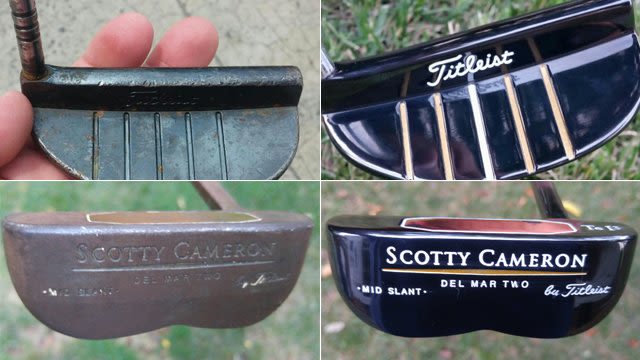Equipment
The art of refinishing or restoring a putter
By T.J. Auclair, PGA.com
Published on

Ask any serious golfer -- no matter the ability -- which club of the 14 in their respective bags is the most difficult to replace and you'll likely get the same answer from the large majority: the putter.
We all have a love-hate relationship with the flatstick. Sometimes it gets put in timeout (as if it's the putter's fault we're missing those testy knee-knockers), but for many, we seem to always turn back to old reliable.
But what happens when that beloved putter is in rough shape? Maybe it's dinged up, rusty, whatever. If you're thinking it's time to ditch it for a new, prettier model, you might want to think again.
Did you know you can actually bring back the beauty of that putter you love that's seen better days and have it looking better than ever?
If you're wondering how that's possible, you may want to take the time to learn a little about a gentleman from North Carolina named Ken Hissam.
Hissam is a self-described "putter geek" whose first memories of playing the game are on the putting green. He comes from a family where both parents were golf nuts. His mother, 90 years old now, still plays twice a week.
Growing up, Hissam recalls his parents hiring a caddie to babysit him while they played. Hissam and the caddies spent all that time on a putting green. And that's where he fell in love with the game... and with putters.
There’s something about a putter
"Out of all the clubs in one's bag, there's a special bond with a putter," he said. "A putter can bring you out of trouble after three horrendous shots or make you look like a complete idiot after just one. Clubs may come and go, but everyone keeps that one putter that won their club championship, a high school match, was their father's or grandfather's or just pulled them out of a 3-way press on the 18th.
Mine is a McGregor IMG 5 that my dad used and gave to me when I was only 11. He passed away a few years ago and once I pulled that putter out of my bag, all the memories came flooding back about my dad and when we played. My dad was the best putter of the ball I had ever seen. I wanted to see the putter how he saw it all those years ago. I wanted to see it like it was new when he picked it up in the pro shop. That started my quest."
Hissam owns Kickstand Putters, which specializes in putter restoration and refinishing for a fraction of what you would pay for new putter. Basically, he can do to your putter what he did to the one his dad gave him as an 11-year-old boy.
So why refinish an old putter instead of dropping $300+ on a new one, off the rack?
"There's something about a great putter that keeps you going back," Hissam said. "It knows you and you know it. There's a history with the putter and if you get a new one you have to go through the courting process again."
Hissam can take an old, beat-up putter, remove the nicks and dings and refinish it with both the finish (black oxide, nickel, black PVD, raw stainless or raw carbon steel) and paint fill of your choosing.
"It's essentially turning your old favorite brand new again," he said. "There are basically two types of putters I work on: carbon and stainless steel. Stainless is more durable, as it will tolerate the elements a lot better than carbon. Carbon will rust over time because of the low nickel and chrome content. Some of the carbon putters that readers will be familiar with are the early Scotty Camerons like the 'Art of Putting' series or the 'Studio Design' series. The 'Pro Platinum' series is also carbon, but it's plated. The best advice is to keep the headcover on it and keep it dry. Another bit of advice is to keep it in your hands and not in the air, meaning don't throw it!"
The key to Hissam's ability to bring that old putter back to life is all in the preparation.
"Sanding, polishing and buffing," he said. "You have to make the putter look worse during the process in order for it to look better. The right equipment is essential. The polishers and buffers you get at the Home Depot or Lowes won't cut it. I use my friend's shop which has all the industrial sanders and polishers."
"Sanding, polishing and buffing," he said. "You have to make the putter look worse during the process in order for it to look better. The right equipment is essential. The polishers and buffers you get at the Home Depot or Lowes won't cut it. I use my friend's shop which has all the industrial sanders and polishers."
Some golfers treat their putter like a newborn. When Hissam restores it, he treats it the same way
"When I first talk to the owner, I set expectations up front," said Hissam, who doesn't take payment until a customer is happy with the finished product. "For example, if there are really bad dings in the face, then we may not be able to save the milling. I share that with the owner. But, I can re-mill the face as well for an additional charge. I let them know the timeframe that they should expect their putter completed. Sometimes, I'll send them photos of the work right after polishing when the putter is ready for black oxide or PVD. Next, I will send them photos of the putter when it's completely restored for their approval. I learned early on that it's all about customer service, communication and exceeding the customer’s expectations."
